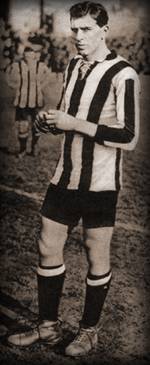
- back line. On the right was Alex Gardner. On the left was emerging Peter McWilliam and as the attacking, Scottish centre-half, Andy Aitken. The problem was that he was somewhat out-of-position. For Scotland Aitken did not play there. He was right half, with McWilliam on the left but Alex Raisbeck or Charles Thomson central, And he was ageing. As a result the team could be rattled. Reports of the Crystal Palace defeat and all three of the lost finals emphasise how, despite Newcastle's obvious sophistication, it could buckle against teams prepared to be physical and use the long-ball well.
- In fact the first rethink did not work. The propensity to fold was not corrected by Andy Aitken being allowed to move on and Colin Veitch moving back to fill the vacancy. And nor might it have been but for a second rethink, firstly positional, moving Veitch to right-half, as Gardner also aged, with twenty-four year-old Wilf Low being bought in from Aberdeen for the 1909-10 season and also tactical, with, although he may or may not have been its source, Bill McCracken an integral part.
The new idea was the Off-side Bogey, what we today call the Offside-Trap, and, although simple in concept it was far more tricky in practice. The stepping-up had to be timed correctly and that was McCracken's genius. As an idea it might have formed in the Scots minds of Colin Veitch or Peter McWilliam or been a cooperation of the both but on the field it was Irish McCracken, now fully established in the team, who called it out and continued to do so long after Veitch and McWilliam had hung up their boots. And because he was so good at it within a playing decade a change of football's basic rules was forced. In 1925 the minimum number of players required between the receiver of the forward ball and the goal was reduced from three to two. Modern off-side had arrived.
